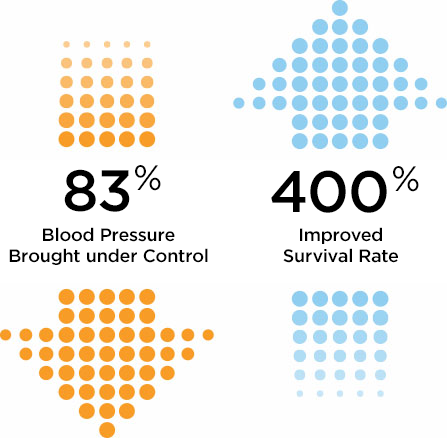The Best Way to Treat a Heart Attack is to Prevent it
Oct 1, 2012

Lifesaving cardiac care
Kaiser Permanente’s Collaborative Cardiac Care Services program in Colorado improved survival rates by nearly 400% and enabled 83% of members to get their blood pressure under control.
— Sandhoff et al., The Permanente Journal, Summer 2008; CDC, September 2012.
Cardiovascular disease is one of the most costly diseases for employers — annual health care expenses for just one employee with heart disease average nearly $19,000.1 Employees with heart conditions also miss an average of eight workdays per year.2 The traditional health care system is designed to detect illnesses after the fact, when they’re more costly to treat. But if your employees received the right preventive care at the right time, it could reduce heart attacks by up to 63%.3 To be proactive, doctors, nurses, and pharmacists need to work together — sharing information, tracking member progress, and supporting your employees.
Susan Mahler, Kaiser Permanente member testimonial (San Diego)
Compared to other health plans, employees under our care get more of the right care: screenings, the right medications, health promotion and education, and care management helping members at risk for heart disease stay healthy. It keeps costs down and your employees healthier.
Helping reduce heart attacks and strokes
Heart disease caught early
Our doctors are prompted to ask members about risk factors for heart disease, such as smoking or lack of exercise, at every routine office visit. And Kaiser Permanente HealthConnect® automatically informs our caregivers when members are due for preventive care screenings. We can schedule them — and sometimes perform them — on the spot, even if they’re not related to that day’s office visit.
Avoid costly hospitalizations
Since our caregivers work together to provide and monitor preventive care and follow-up for patients, they’re able to provide a personalized level of care that helps employees stick with preventive care programs, follow recommended treatment plans, and miss less work. Evidence shows that a coordinated team approach to cardiac care reduces hospitalizations for patients with heart disease.4
More productive employees
80% of members who participated in our online chronic care management program said their health improved — saving $2,148 in projected productivity per year per participant.5
No referrals required
Members at risk for cardiac disease are automatically enrolled in our award-winning disease management programs at no additional charge.
Top-ranked cardiac care
According to 2014 HEDIS® scores, we had the highest rates for cholesterol and blood pressure control for members with heart disease in every state we serve plus the District of Columbia.6
Getting back on track: A successful heart surgery has runner Sarah Phelan back on her feet.





DID YOU KNOW
— Ostrow, Bloomberg.com, November 5, 2012.